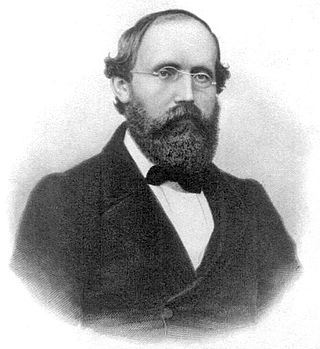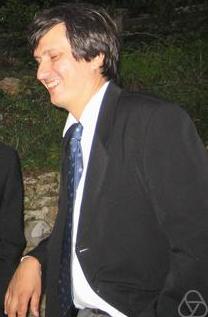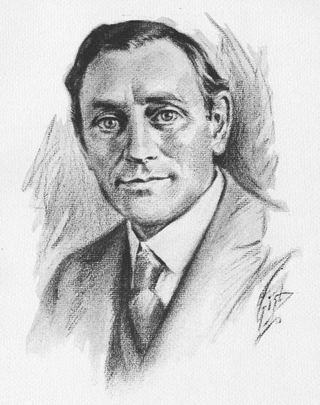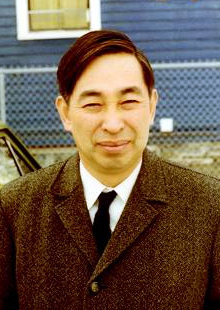Calculus is the mathematical study of continuous change, in the same way that geometry is the study of shape, and algebra is the study of generalizations of arithmetic operations.

In mathematics, an integral is the continuous analog of a sum, which is used to calculate areas, volumes, and their generalizations. Integration, the process of computing an integral, is one of the two fundamental operations of calculus, the other being differentiation. Integration was initially used to solve problems in mathematics and physics, such as finding the area under a curve, or determining displacement from velocity. Usage of integration expanded to a wide variety of scientific fields thereafter.

Georg Friedrich Bernhard Riemann was a German mathematician who made profound contributions to analysis, number theory, and differential geometry. In the field of real analysis, he is mostly known for the first rigorous formulation of the integral, the Riemann integral, and his work on Fourier series. His contributions to complex analysis include most notably the introduction of Riemann surfaces, breaking new ground in a natural, geometric treatment of complex analysis. His 1859 paper on the prime-counting function, containing the original statement of the Riemann hypothesis, is regarded as a foundational paper of analytic number theory. Through his pioneering contributions to differential geometry, Riemann laid the foundations of the mathematics of general relativity. He is considered by many to be one of the greatest mathematicians of all time.

Henri Léon Lebesgue was a French mathematician known for his theory of integration, which was a generalization of the 17th-century concept of integration—summing the area between an axis and the curve of a function defined for that axis. His theory was published originally in his dissertation Intégrale, longueur, aire at the University of Nancy during 1902.

Adrien-Marie Legendre was a French mathematician who made numerous contributions to mathematics. Well-known and important concepts such as the Legendre polynomials and Legendre transformation are named after him. He is also known for his contributions to the method of least squares, and was the first to officially publish on it, though Carl Friedrich Gauss had discovered it before him.

Maxim Lvovich Kontsevich is a Russian and French mathematician and mathematical physicist. He is a professor at the Institut des Hautes Études Scientifiques and a distinguished professor at the University of Miami. He received the Henri Poincaré Prize in 1997, the Fields Medal in 1998, the Crafoord Prize in 2008, the Shaw Prize and Breakthrough Prize in Fundamental Physics in 2012, and the Breakthrough Prize in Mathematics in 2015.

Mathematical physics refers to the development of mathematical methods for application to problems in physics. The Journal of Mathematical Physics defines the field as "the application of mathematics to problems in physics and the development of mathematical methods suitable for such applications and for the formulation of physical theories". An alternative definition would also include those mathematics that are inspired by physics, known as physical mathematics.
In algebra, ring theory is the study of rings—algebraic structures in which addition and multiplication are defined and have similar properties to those operations defined for the integers. Ring theory studies the structure of rings, their representations, or, in different language, modules, special classes of rings, as well as an array of properties that proved to be of interest both within the theory itself and for its applications, such as homological properties and polynomial identities.
Lists of mathematics topics cover a variety of topics related to mathematics. Some of these lists link to hundreds of articles; some link only to a few. The template to the right includes links to alphabetical lists of all mathematical articles. This article brings together the same content organized in a manner better suited for browsing. Lists cover aspects of basic and advanced mathematics, methodology, mathematical statements, integrals, general concepts, mathematical objects, and reference tables. They also cover equations named after people, societies, mathematicians, journals, and meta-lists.

Harry Bateman FRS was an English mathematician with a specialty in differential equations of mathematical physics. With Ebenezer Cunningham, he expanded the views of spacetime symmetry of Lorentz and Poincare to a more expansive conformal group of spacetime leaving Maxwell's equations invariant. Moving to the US, he obtained a Ph.D. in geometry with Frank Morley and became a professor of mathematics at California Institute of Technology. There he taught fluid dynamics to students going into aerodynamics with Theodore von Karman. Bateman made a broad survey of applied differential equations in his Gibbs Lecture in 1943 titled, "The control of an elastic fluid".
Calculus, originally called infinitesimal calculus, is a mathematical discipline focused on limits, continuity, derivatives, integrals, and infinite series. Many elements of calculus appeared in ancient Greece, then in China and the Middle East, and still later again in medieval Europe and in India. Infinitesimal calculus was developed in the late 17th century by Isaac Newton and Gottfried Wilhelm Leibniz independently of each other. An argument over priority led to the Leibniz–Newton calculus controversy which continued until the death of Leibniz in 1716. The development of calculus and its uses within the sciences have continued to the present.

Alberto Pedro Calderón was an Argentinian mathematician. His name is associated with the University of Buenos Aires, but first and foremost with the University of Chicago, where Calderón and his mentor, the analyst Antoni Zygmund, developed the theory of singular integral operators. This created the "Chicago School of (hard) Analysis".
The Leroy P. Steele Prizes are awarded every year by the American Mathematical Society, for distinguished research work and writing in the field of mathematics. Since 1993, there has been a formal division into three categories.

Kiyosi Itô was a Japanese mathematician who made fundamental contributions to probability theory, in particular, the theory of stochastic processes. He invented the concept of stochastic integral and stochastic differential equation, and is known as the founder of so-called Itô calculus. He also pioneered the world connections between stochastic calculus and differential geometry, known as stochastic differential geometry, invited for the ICM in Stockholm.
Ralph Henstock was an English mathematician and author. As an Integration theorist, he is notable for Henstock–Kurzweil integral. Henstock brought the theory to a highly developed stage without ever having encountered Jaroslav Kurzweil's 1957 paper on the subject.
Herbert Federer was an American mathematician. He is one of the creators of geometric measure theory, at the meeting point of differential geometry and mathematical analysis.

The Institute of Mathematics of National Academy of Sciences of Armenia is owned and operated by the Armenian Academy of Sciences, located in Yerevan.

A timeline of calculus and mathematical analysis.

In mathematics, the integral of a non-negative function of a single variable can be regarded, in the simplest case, as the area between the graph of that function and the X axis. The Lebesgue integral, named after French mathematician Henri Lebesgue, extends the integral to a larger class of functions. It also extends the domains on which these functions can be defined.
Victor Hugo Moll is a Chilean American mathematician specializing in calculus.











